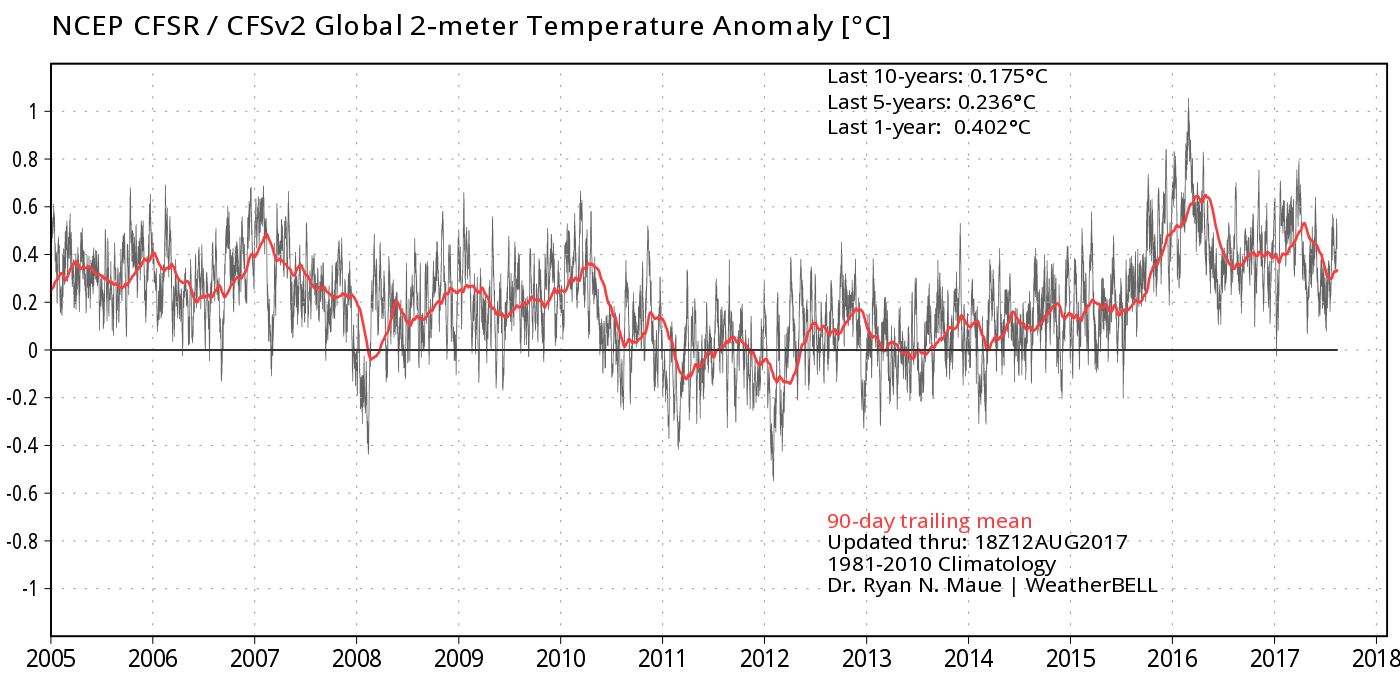tl;dr- This claim is false and has been retracted. The figure shown in the claim is wrong because it used one data interpretation method before 2010 and then switched to another after that, causing a false trend.
Update
As explained in @DikranMarsupial's answer, the source of this claim has retracted it as mistaken. The website that hosted the original plot has removed it from their page, though they appear to still have other graphs with the same mistake.
"Climate Science Denial Group GWPF Admits It Used False Temperature Graph" (2017-08-14) explains their take on these events. As they tell it, the original plot produced by Ryan Maue was factually incorrect, leading the GWPF to retract their claim based on that plot.
However, the plot was already known to be bad. This falsehood was pointed out to Maue on Twitter over a year before the claim was made:

The above tweet shows both the incorrect plot that this claim was based on and a corrected version of it.
@DavidHammen's answer has more technical information and perspective on the topic.
Original tl;dr- This is a partial answer because the data analysis here will require additional research. The data in the plot is heavily reinterpreted (it's not raw data), and literature on the topic discusses how this reinterpretation is highly subjective. So, is the data reflective of the climate change issue like the claim implies? I suspect not, but establishing why it's not would require further investigation.
I'd note that the source of this claim is blatantly political and seems to misrepresent a lot of information related to climate change (in addition to a strange obsession with Al Gore). As such, I think that it's a reasonable assumption that that's probably what's happening here as well. However a more complete answer would find exactly what the definition and significance of the plotted data.
It looks like the original plot came from "Weather Bell Models", however it was edited to include the "Gore wins nobel prize" and "Temps now" labels.

Unfortunately, the source website is difficult to read through and to search.
The label at the top of the plot says
NCEP CFSR / CFSv2 Global 2-meter Temperature Anomaly [°C]
To interpret that:
This data appears to be from "Seasonal climate forecast from CFSv2":
This page displays seasonal climate anomalies from the NCEP coupled forecast system model version 2 (CFSv2). Forecasts are from initial conditions of the last 30 days, with 4 runs from each day. Forecast ensembles consist of 40 members from initial a period of 10 days. The 1st ensemble (E1) is from the earliest 10 days, the 2nd ensemble (E2) from the second earliest 10 days, and 3rd ensemble (E3) from the latest 10 days. Aomalies are with respect to 1999-2010 hindcast climatology. Temporal correlations between hindcasts and observations are used as skill mask for spatial anomalies. Standard deviation to normalize anomalies is the average standard deviation of individual hindcast members. For SSTs, anomalies with respect to 1982-2010 climatology are available here.
CAUTION: Seasonal climate anomalies shown here are not the official NCEP seasonal forecast outlooks. The NCEP seasonal forecast outlooks can be found at CPC website. Model based seasonal climate anomalies are one factor based on which NCEP seasonal forecast outlook is issued.
This website provides data for "T2m", which literature papers seem to use as a shorthand for "temperature at 2-meters above surface level", as claimed in the plot.
Complication: This isn't raw data
A potential complicating factor is that we're not dealing with raw data, but "reanalyzed" data, which is what the CSFR project is all about. Apparently reanalysis for T2m is particularly subjective:
3 Climatology
In this section, we present an analysis of the annual mean climatology. We will first compare spatial maps among reanalyses and observations for precipitation, SST and the related surface heat fluxes. Climatology of the full T2m field is not discussed in this section, as it strongly depends on the topography used for each reanalysis.
-An assessment of the surface climate in the NCEP climate forecast system reanalysis (2010)
That same paper goes on to discuss more about the issue of T2m reinterpretation:
4 Variability
In this section, we assess the variability of precipitation and T2m. We begin with a comparison of precipitation among R1, R2, and CFSR to see if changes in model physics during the past 15 years or so, together with the use of much higher resolution of the CFSR, lead to an improved representation of observed weather systems. We will then move on to a comparison of interannual variability of monthly anomalies among reanalyses and observations.
-An assessment of the surface climate in the NCEP climate forecast system reanalysis (2010)
So, that's where this partial answer leaves off at: interpreting the significance of the reinterpreted T2m data.







